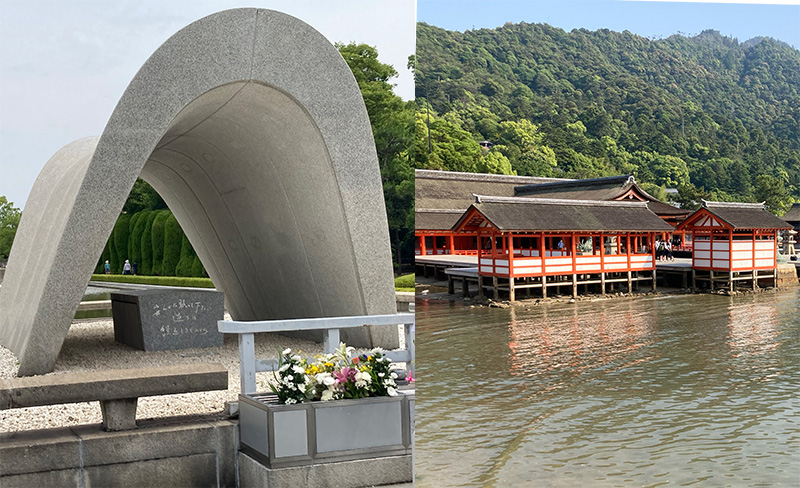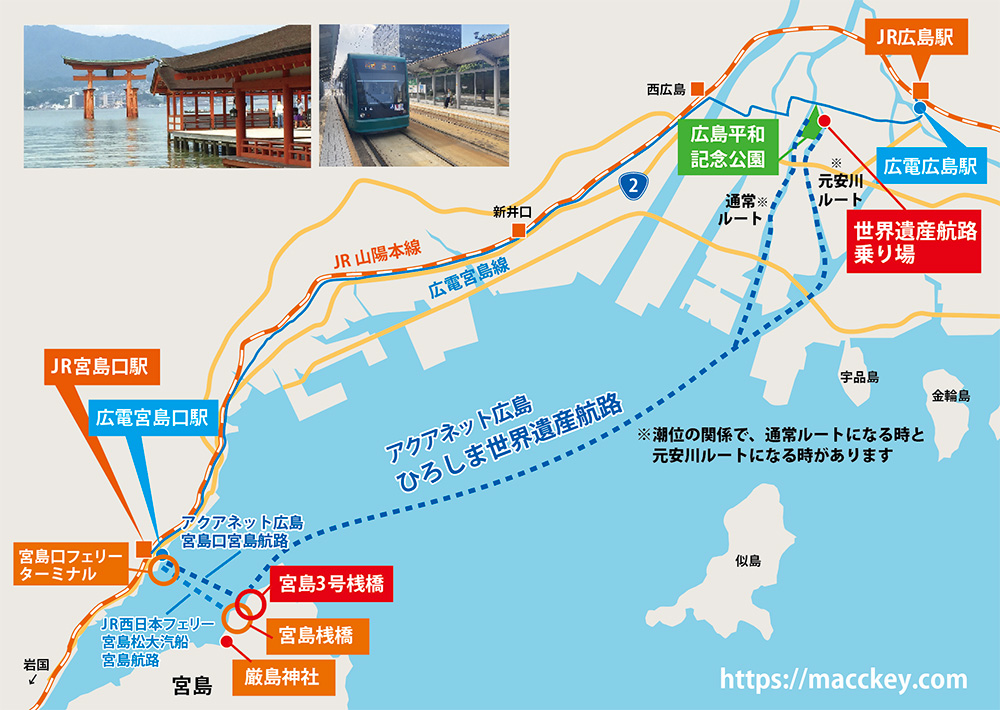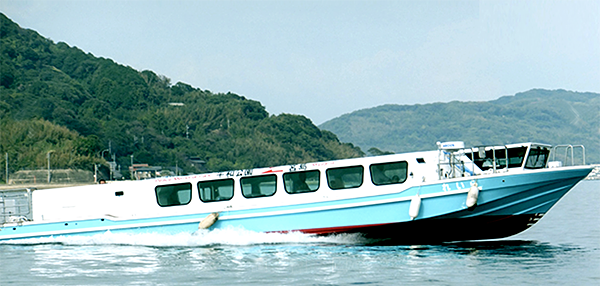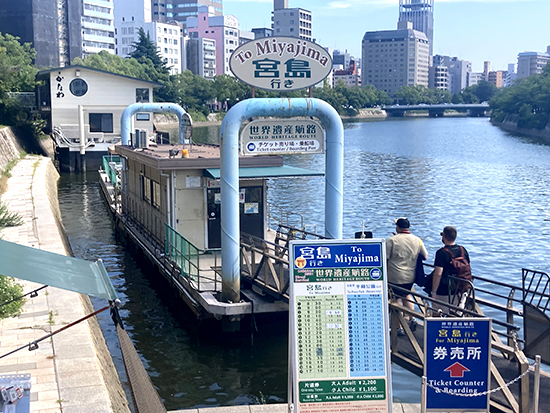For those who come to Hiroshima on vacation, sightseeing at Hiroshima Peace Memorial Park andMiyajima (Itsukushima Shrine) is a must, isn’t it?
Of course, there are many other places to see in Hiroshima, but as a local, I strongly recommend that you visit these two places.

If you want to visit both places in one day, you can usually take a streetcar to Miyajima-guchi and then take a ferry across the island.
This is the “Hiroshima World Heritage Route” operated by a company called Aquanet Hiroshima, and this article will focus on this route. I will also compare this route with train and ferry travel, as well as write about its merits and demerits.
Directly from Hiroshima Peace Memorial Park to Miyajima by boat! What is the “Hiroshima World Heritage Route”?
As I mentioned at the beginning of this article, I would like to write a little more about this “Hiroshima World Heritage Route.
JR Nishinippon Miyajima Ferry and Miyajima Matsudai Kisen are the two most common boats for Miyajima, but there is another service operated by Aquanet Hiroshima Inc. that connects Hiroshima Peace Memorial Park and Miyajima directly by high-speed boat, the “Hiroshima World Heritage Route.
JR and Matsudai Steamship operate the route between Miyajima-guchi and Miyajima on the other side of the island, so of course one must take the JR Sanyo Main Line or Hiroshima Electric Railway to “Miyajima-guchi. However, Aquanet Hiroshima’s route can go directly to Miyajima from the Peace Memorial Park, which is a big difference and a big advantage.
I drew an image map of the whole area. It looks like this.

Although there are some points such as the fare, the fact that you can go directly to Miyajima without changing trains is a big advantage. Moreover, it is refreshing to go along the river and the sea! (*^o^*)
Comparison of the Hiroshima World Heritage Route with the train
Now, let’s compare the price, time, etc. between the Hiroshima World Heritage Route and the city train.
| Hiroshima World Heritage Route | By city train and ferry | |
|---|---|---|
| Route | Directly from Hiroshima Peace Memorial Park to Miyajima Pier No. 3 | Take a train from in front of the Atomic Bomb Dome to Miyajima-guchi and transfer to a ferry from Miyajima-guchi to Miyajima Pier |
| Operating company | Aquanet Hiroshima | Hiroshima Electric Railway, JR Nishinippon Miyajima Ferry or Miyajima Matsudai Kisen (either one) |
| Fare | One-way: Adults 2,200 yen (2,300 yen through to Miyajima-guchi), round trip: Adults 4 ,000 yen | One way Adult 450 yen (Train 270 yen + Boat 180 yen) |
| Time required | Approx. 45 min. | Approximately 1 hour and 20 minutes (assuming the train takes about 60 minutes, 10 minutes for transfers and waiting for the boat, and 10 minutes for the ferry) |
| Advantages | You can enjoy the view of the river and the sea in Hiroshima. Fast | Inexpensive |
| Disadvantage | Expensive. | It takes time. If the train is crowded, it may be a little tiring. |
| Remarks | Since the company’s Miyajima-guchi Miyajima route is now in service, you can use the Miyajima-guchi route on the way to Miyajima and take a train or JR on the way back from Miyajima-guchi. | If you purchase a “one-day pass” (900 yen for adults) for Hiroshima Electric Railway, you can save money if you take the train to other destinations. |
After all, the big difference is the fare. If you take the city train, you can go from A-bomb Dome-mae to Miyajima for a total of 450 yen, but if you go directly to Miyajima, the cost is 2,200 yen. What do you think of this price difference?
In terms of merits and demerits, the Hiroshima World Heritage Route’s “speed,” “no need to change trains,” and “beautiful scenery of the river and sea” are major merits.
Conversely, if you use the city train, it is “slow,” “you have to change trains,” and “the scenery is not particularly nice (note: the sea is beautiful when you get close to Miyajima).
Incidentally, my impression is that many foreigners use the Hiroshima World Heritage Route.
Of course, there are Japanese tourists as well, but I think that those from overseas may be more likely to “not worry so much about the money” and “prefer to use the easy-to-understand route without the hassle of transfers, etc.
So, who is suited to the Hiroshima World Heritage Route?
I have just written about the advantages and disadvantages of this route, but in the end, it depends on whether you understand them and think it is a good idea or not.
- People who want to visit both Peace Memorial Park and Miyajima on the same day.
- People who don’t know much about local trains and transfers and want a hassle-free trip
- People who think that traveling by boat with a view of Hiroshima’s river and ocean would be lovely.
- People who think it is better to travel as fast as possible.
- People who don’t mind paying a little more if it makes all of the above possible.
If you are one of these people, this route is suitable for you and you will be satisfied with it.
Outline of Hiroshima World Heritage Route
Operating hours
Depending on the tide level, there may be cancellations, and sometimes there are extra services on Saturdays and Sundays, so I can’t write anything definite,
Basically
From Peace Park to Miyajima
Departure: 08:30 (Arrival: 09:15) – 17:10 (Arrival: 17:55), approximately every 30~35 minutes
From Miyajima to Peace Park
08:40 (09:25) – 17:30 (18:15), approximately every 30 to 35 minutes.
Fare
There are one-way and round-trip tickets.
| One-way ticket | Adult (junior high school students and older) 2,200 yen |
|---|---|
| Child (elementary school student) 1,100 yen |
| Round trip | Adult (junior high school student or older) 4,000 yen |
|---|---|
| Child (elementary school student) 2,000 yen |
- One infant under elementary school age is free per adult.
- Return tickets are valid for 2 days.
- There is no group discount.
- Cancellation after ticket purchase may not be accepted if made less than 15 minutes prior to departure.
- Discounts are available for disabled persons. (One person with a Class 1 Disability Certificate and one caregiver: 1,100 yen one-way, 2,200 yen round-trip / per person)
About the ship
Gross tonnage / 19 tons
Overall length / 19.40m
Overall width/4.26m
Passenger capacity / 100 passengers
About Reservations
Reservations can be made by phone at 082-240-5955 from 8:00 to 19:00.
Web reservations are accepted 24 hours a day, until 20:30 the day before boarding *Reservation page on the official website
Reservations cannot be made by phone on the day of embarkation.
If you wish to board the boat on the same day without a reservation, you must go directly to the pier and purchase a same-day ticket for a flight that has seats available.
We recommend making reservations if at all possible.
Where is the boarding area for the Hiroshima World Heritage Route?
The boarding area on the Peace Memorial Park side is at the east end of Motoyasu Bridge, which spans the Motoyasu River in Peace Memorial Park. It is about a 3-minute walk from the A-bomb Dome straight south along the river.



Comments